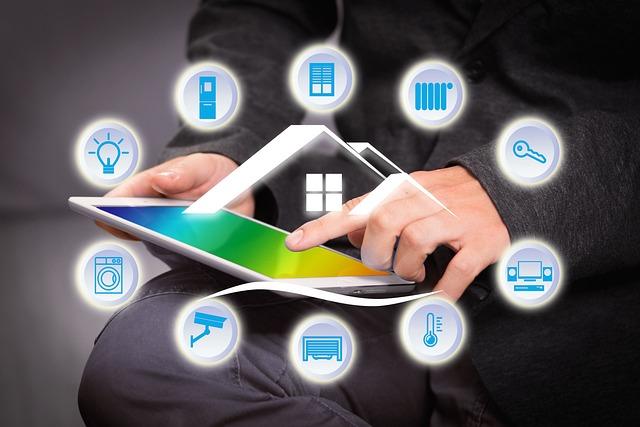In an era where technology seamlessly integrates into every facet of our daily lives, the concept of a smart home has evolved from a futuristic dream to a tangible reality. Creating a modern smart home for premium living is not merely about adopting the latest gadgets; it’s about orchestrating a symphony of interconnected devices that enhance comfort, efficiency, and security. This article delves into the strategic considerations and cutting-edge innovations that define a sophisticated smart home. By examining the key components and technologies, we will guide you through the process of transforming your living space into a hub of intelligence and luxury. With a confident grasp on the latest advancements, you can elevate your home environment to unprecedented levels of convenience and elegance.
Understanding Smart Home Ecosystems and Integration
In the realm of modern living, the concept of a smart home has transcended beyond mere automation to become a cohesive ecosystem where various devices work in harmony. Smart home ecosystems integrate a myriad of devices, from lighting and climate control to security systems and entertainment hubs, creating a seamless experience that enhances convenience, efficiency, and comfort. At the core of these ecosystems lies the principle of interoperability, where devices from different manufacturers communicate effectively, often through centralized platforms like Apple HomeKit, Google Home, or Amazon Alexa.
To fully leverage the potential of a smart home ecosystem, consider the following key elements:
- Compatibility: Ensure that your devices are compatible with your chosen smart home platform to avoid integration issues.
- Central Hub: Use a central hub to manage and control all your devices, allowing for synchronized operations and automation.
- Network Stability: A robust and secure Wi-Fi network is essential for the smooth operation of interconnected devices.
- Security Protocols: Implement strong security measures to protect your data and prevent unauthorized access.
By thoughtfully selecting and integrating smart devices, you create a living space that not only responds to your needs but also anticipates them, offering a truly premium living experience.

Choosing the Right Devices for Seamless Automation
In the pursuit of a seamless automation experience, the selection of devices is pivotal. The foundation of a modern smart home is built upon compatibility and integration. When evaluating devices, consider those that support open platforms like Zigbee or Z-Wave, which facilitate communication across different brands and products. This ensures that your smart lights, thermostats, and security systems work harmoniously without the need for multiple apps or controllers.
Key factors to weigh include:
- Scalability: Choose devices that allow for easy expansion as your needs evolve.
- Energy Efficiency: Opt for products that not only save power but also provide detailed energy consumption data.
- Voice Assistant Compatibility: Ensure devices are compatible with popular voice assistants like Alexa, Google Assistant, or Siri for hands-free control.
- Security Features: Prioritize devices with robust security protocols to safeguard your personal data.
By focusing on these aspects, you can create a cohesive and efficient smart home ecosystem that enhances your living experience, providing both convenience and peace of mind.

Enhancing Security and Privacy in a Connected Home
In the quest for a seamlessly integrated smart home, security and privacy become paramount. As we intertwine technology into our living spaces, ensuring that our personal data and safety remain uncompromised is crucial. To achieve this, consider implementing a robust multi-layered security approach. This can include:
- Strong Network Security: Utilize a high-quality router with built-in firewall capabilities and ensure your Wi-Fi network is encrypted with WPA3.
- Device Authentication: Enable two-factor authentication on all smart devices and applications to add an extra layer of protection.
- Regular Updates: Keep all software and firmware up to date to protect against vulnerabilities.
- Smart Device Management: Regularly review and manage permissions for all connected devices to ensure they only access necessary data.
Additionally, adopting privacy-centric devices can safeguard against unwanted data breaches. Opt for products that prioritize user privacy by design and offer transparency regarding data handling practices. By integrating these strategies, your smart home will not only enhance your lifestyle but also secure your peace of mind.

Maximizing Energy Efficiency with Smart Technology
In the pursuit of a more energy-efficient lifestyle, smart technology emerges as a formidable ally. By integrating smart thermostats, intelligent lighting systems, and automated energy management tools, homeowners can significantly reduce energy consumption while maintaining comfort and convenience. These technologies allow for real-time monitoring and adjustment of energy use, optimizing consumption patterns based on user behavior and preferences.
- Smart Thermostats: Adjust heating and cooling based on occupancy and weather forecasts, ensuring optimal energy use.
- Intelligent Lighting: Utilize sensors and schedules to turn off lights when not needed, enhancing both energy savings and security.
- Automated Energy Management: Analyze and control the energy consumption of appliances, identifying high-use areas and suggesting improvements.
By leveraging these technologies, a modern smart home not only reduces its carbon footprint but also enhances the overall living experience, offering a seamless blend of luxury and sustainability.



